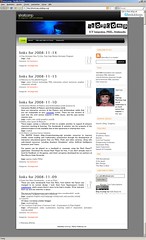links for 2008-11-23
-
# Your type formula according to Carl Jung and Isabel Myers-Briggs typology along with the strengths of the preferences
# The description of your personality type
# The list of occupations and educational institutions where you can get relevant degree or training, most suitable for your personality type – Jung Career Indicator™
Affinity Diagramming/Card Sorting
A PEEL Strategy that I learnt to do from the Usability Research branch of the University of Technology, Sydney was Affinity Diagramming. UTS/Usability labs used this to summarise primary research, where important points within the research were placed onto post-it notes, and then sorted and categorised into different sections. I found this really useful, and have since used it for any research or essay I have written.
I recently stumbled across this post (link) in the Content Literacy Ning which inspired me to write about my experiences.
I have also used it quite extensively within the classroom. Students are presented with different information resources on a topic, and a packet of different coloured postit notes. Students are asked to record each of the main concepts that are presented within their resource on a separate note. Students then group their cards into related categories by physically moving them around. They then summarise the information within each category into a paragraph, using the category as their topic sentence and post-it notes as supporting information.
This PEEL strategy is used to teach students how to analyse and synthesise information obtained from multimedia resources. It teaches students essay and extended response writing skills and how to organize information into categories. This strategy aids all ability levels, particularly students who struggle with the organisation of information, Kinesthetic learners benefit from this strategy, as they more effectively learn when given the opportunity to move out of their seat and physically interact with the content. Similarly, this strategy assists visual learners who have the ability to visually conceptualise the information and therelationships between components assisting the retention of content information. By simultaneously catering for various academic abilities and multiple intelligences, this activity identifies itself as a learning strategy that can promote effective learning.
Image Attribution: http://flickr.com/photos/cannedtuna/1423599488/
links for 2008-11-16
Browser compatability
I have been following Steve Dembo’s 30 days to a better blog in order to motivate me to update and improve the blog. I’m about 4 days behind already, but considering that I’ve been HSC Marking, that’s not too bad.
This morning, I’ve added a new RSS feed and email capabilities.
The next challenge is to test your blog in different browsers. Since I’m extremely lazy at this, about 6 months ago I found this website: http://browsershots.org/ which you can select different browsers and operating systems, and after about five minutes or so, the website will send you back screen captures for each browser, in each operating system. This is a fantastic system, that until now, I’d only used to test student websites. Below are my screen captures from this site:




links for 2008-11-14
links for 2008-11-13
links for 2008-11-10
-
Interactive Models of Platonic and Archimedean Solids
Here are interactive versions of the Platonic and Archimedean solids that you can manipulate on your computer screen. There are two versions of each one; the vrml version requires a VRML viewer, and the java version requires java. -
These pages contain a collection of links to suitable activities to support & enhance classroom teaching & learning. The thumbnails & activities are the property of the authors/creators & only available due to their generosity in sharing their work.
-
The MATRIX Project (http://matrixlearning.org) provides resources to improve middle school reading and mathematics achievement through the development of interactive educational games that use PDAs, iPods and video cameras, along with web-based resources including Quantum Simulations' online Artificial Intelligence Assessors and Tutors.
Our games can be played on a handheld or computer using the Flash Player™ application. Download the newest Flash Player for free, if you don't already have it. Send Us Feedback on the games, and check out games developed by our partners at New Mexico State University.
links for 2008-11-09
-
These are early storyboards from Star Wars, from before the Falcon was changed to its current design. I took them from Hyperspace's Insider supplement, which means there's more to be had in Insider. I'll try and pick them up and see what this is about.
The text on the Hyperspace page (which requires membership), reads:
"Insider readers who enjoyed J.W. Rinzler's revealing "Pirates of the Boards" article from issue #91 can view the rare storyboard artwork here in an enlarged slideshow format — please see the original article for additional information regarding these rare images.
Be sure to check out Rinzler's continuing series of early storyboard art in the next five issues of Star Wars Insider!"
To my knowledge, the majority of these storyboards were done by Joe Johnston.
PS: I'm attaching a few more proto-storyboards storyboards to this set, as I find them.
links for 2008-11-07
-
So, you're interested in origami and mathematics…perhaps you are a high school or K-8 math teacher, or a math student doing a report on the subject, or maybe you've always been interested in both and never made the connection, or maybe you're just curious. Origami really does have many educational benefits. Whether you are a student, a teacher, or just a casual surfer, I have tried my best to answer your questions, so please read on.